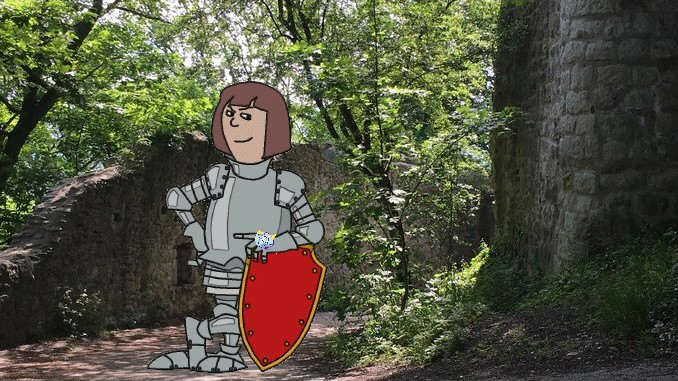
The ruin of the medieval donjon of Drachenfels Castle is a landmark of Königswinter and the Siebengebirge. You can go up there, and enjoy the breathtaking view across the Rhine valley. Today we only have the donjon and some inner walls left, and it is a bit difficult to imagine how it was like back then in the Middle Ages.
Mighty archbishops
Let us go back to the High Middle Ages, early Hohenstaufen era. The Archbishops of Cologne were powerful men. Here we have a special political configuration of the Holy Roman Empire: the archbishops of Cologne, Mainz and Trier were not only high ecclesiastical dignitaries, but also important political actors in the Empire. The acting Archbishop, Rainald von Dassel, was emperor Frederick Barbarossa’s chancellor. Diplomatic missions to him abroad, also to the court of Henry II Plantagenet to win him over to Barbarossa’s side against the Pope.
They also had their say in our region. Since 1118 their castle stood on Mount Wolkenburg; it was the first castle in the Siebengebirge. But their supremacy in the region was more and more disputed by the Counts of Sayn from the south and the Counts of Berg from the north.
Building the castle
To fortify his position, in 1140 the Archbishop Arnold I of Merxheim (1137-1151) gave order to build a castle on the Drachenfels. But his men plundered in the surrounding villages, destroying fields and vineyards. Many of them belonged to the St. Cassius-Stift in Bonn. Consequently, abbot Gerhard of Are wanted to purchase the castle. But only when the archbishop himself got in trouble, he gave in. In 1149, the St. Cassius-Stift became the new owner of Drachenfels Castle.
In 1167, Drachenfels Castle was finished. It was a hilltop castle, well protected by its location and bretèches with machicolations. Attackers could hardly bring up heavy siege equipment; they were also exposed to fire arrows and stones.
The burgraves
The St. Cassius-Stift charged ministeriales to run their castle. These people were unfree nobles who took on administrative tasks and also held military responsibilities. On the Drachenfels we meet a man called Godart, his name addition “of Drachenfels” meant that he worked on Drachenfels castle, not that he owned it. But this arrangement turned out expensive, so around 1200, the St. Cassius Stift granted the castle as fiefdom to their ministeriales, receiving a part of the income in return. Around 1225, the first burgrave Heinrich of Drachenfels appeared in historical sources. Burgrave sounds similar to landgrave, yet a landgrave was a member of the high nobility, a burgrave was not.

Stones from the Drachenfels for the cathedral in Cologne
The burgraves of Drachenfels lived through heights and depths. In 1248, Archbishop Konrad von Hochstaden had laid the foundation stone for the new Gothic cathedral in Cologne. A good time for the burgraves of Drachenfels began because the Drachenfels trachyte was the perfect stone. It didn’t get long to get into business, and soon the burgraves became wealthy men.
In terms of politics, however, difficult times began. In the 1280s, the war of the Limburg Succession between the Archbishop Siegfried II of Cologne and Duke John I of Brabant raged and led to the bloody battle of Worringen 1288. The Archbishop and his allies, among them the burgraves of Drachenfels, Wolkenburg and the Count of Löwenburg, suffered a terrible defeat. The burgraves were taken prisoner by the Count of Berg and had to pledge loyalty to him. The Archbishops’ supremacy in the Rhineland was gone, and so was their hold on the city of Cologne, and they never recovered.

Godart of Drachenfels
The burgraves on Drachenfels Castle did recover. In the late Middle Ages, at the time of the Luxembourgers, we meet the probably most famous burgrave of the Drachenfels, Godart, he had made a fortune with the trachyte from the Drachenfels. An anecdote says that he always wore a ring with a precious stone – a piece of trachyte of the Drachenfels!
Large areas on the left bank of the Rhine were his, that’s why we call them still today “Drachenfelser Ländchen”. The Archbishop of Cologne was highly indebted to him, and in 1425 he had to pawn the Wolkenburg mountain with the castle on its top and the village of Königswinter to him.
Godart no longer lived at Drachenfels Castle, but in a comfortable and heated city apartment in Königswinter. Let us close the chapter about the lords of the castle here.
Family conflict
Since the middle of the 15th century, a conflict was smoldering in the burgrave family. We don’t know much about it because there was fighting all over the region. In 1493, Burgrave Heinrich killed his cousin Claus. Today, a stone cross stands at the scene of the crime, a place called Kuckstein (in front of the Nibelungenhalle). Heinrich was the last of the counts of the Drachenfels, he died in 1530.

Be the first to comment